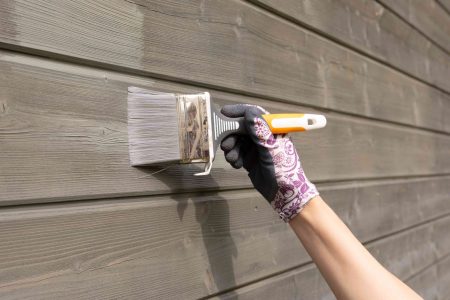When you have a shed that needs to be moved, it may seem like a daunting, even impossible, task. With some wooden sheds approaching half the weight of a midsize car, that’s a reasonable assumption. But with just a few simple tools, patience, and careful planning, it is possible for one or two people to move a heavy shed across a level yard.
Before You Begin
The secret to moving incredibly heavy objects is to use rollers and tracks. This method helped the Egyptians 4,500 years ago move 2-1/2 ton stone blocks, and the same method can be used by you to move a shed.
Three parallel two-by-eights, a few feet away from each other, form the tracks. Rollers are 2-inch diameter galvanized steel pipes.
When to Move a Shed
The best time to move a shed is when the ground is dry, well-drained, and firm. In most areas, spring to late summer is the best time to move the shed. In winter, if the ground is frozen solid, this also provides a firm base for the move.
Shed Weights
Aluminum and plastic sheds under 64 square feet usually weigh 600 pounds or less. But wood sheds can weigh up to three times as much.
| Weight | Material Type | Shed Size |
| 1,800 pounds | Wood with composite shingle roof | 12-foot by 12-foot |
| 1,750 pounds | Wood with composite shingle roof and 7-1/2-foot long porch | 8-foot by 8-foot |
| 1,400 pounds | Wood with composite shingle roof | 8-foot by 8-foot |
| 800 pounds | Wood with metal roof | 8-foot by 6-foot |
| 600 pounds | All plastic | 20-foot by 8-foot |
| 600 pounds | All aluminum | 9-foot by 6-foot |
Safety Considerations
Moving a shed is potentially hazardous if precautions are not taken. Garden sheds are extremely heavy and must be jacked up; they cannot be lifted by hand. Use jacks rated for your shed weight. Do not use a fulcrum and lever. Sheds cannot be pushed or pulled across the ground without assistive devices like rollers. Never place any part of your body under the shed.
What You’ll Need
Equipment / Tools
- Drill and driver bits
- 2 farm jacks (3 ton rated)
- Wrench set or socket set
- Shovel
- Tamping tool
Materials
- 6 two-by-eights
- 2 two-by-sixes (optional)
- 3 3-1/8-inch by 7-inch 20-gauge galvanized steel mending plates
- 8 1/4-inch by 3-inch hex lag screws
- 4 2-inch diameter galvanized steel pipes slightly wider than the shed
Instructions
-
Prepare Shed’s New Site
Have the shed’s new installation site prepared well in advance of moving the shed.
-
Empty Items From Shed
Remove all loose items from inside to lighten the load. Move everything: lawn mowers, bags of fertilizer and soil, pots, garden tools, mobile workbenches, items inside cabinets and on shelves, and more.
-
Remove Heavy Fixed Items From Shed
Remove all fixed items in the shed that are relatively easy to remove. Use the cordless drill and driver bits to remove large shelves, wall cabinets, and workbenches attached to the walls or floor. High wall cabinets are often attached to the wall only by four screws. On the outside, remove window boxes that may contain soil and plants.
-
Prepare Pathway
Use a shovel and tamping tool to level, compact, and smooth the pathway from the shed to its new location.
-
Jack End of Shed
With the farm jacks supported below by scrap two-by-eights or similar, jack up the front end of the shed to 6 inches high. The jacks should be placed inward from the sides of the shed by 18 inches to allow for later placement of the tracks.
-
Lay First Set of Tracks Under Shed
Push the two-by-eight tracks under the shed, parallel to the path to the new location. Center the two end tracks between the jacks and the edges of the shed and the third track in the center.
-
Place Rollers on Tracks
Place the four rollers perpendicular to the tracks:
- One roller as far back as possible
- One roller toward the front (near the jacks)
- Two rollers in the middle of the first two and equidistant from each other
-
Lower End of Shed
Lower the farm jacks so that the shed now rests completely on the rollers.
-
Add Second Set of Tracks
Push the three remaining two-by-eights against the ends of the three tracks already in place.
-
Roll Shed on Tracks
From the back of the shed, push the shed forward. As soon as the back of the shed has cleared the back roller, transfer it to the front. Keep cycling rollers from back to front.
-
Move First Set of Tracks
As soon as the shed has passed onto the second set of tracks, transfer the first set of tracks (now in back) to the front again.
-
Remove Rollers
With the shed at the desired site, jack up one end to 6 inches, slide out as many rollers as possible, then lower the shed. Jack up the opposite end to remove the remaining roller or two.
-
Remove Tracks
To remove the tracks, jack up the two ends of the shed perpendicular to the first two ends. First, jack up one end and remove the end track and the middle track. Then, jack up the opposite end and remove the remaining track.
When to Call a Professional
If the ground is not level or if you need to raise or lower the shed at its eventual location, hire a general contractor to move the shed.
Read the full article here














